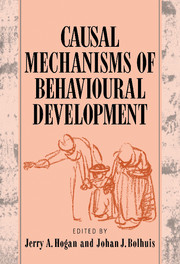Book contents
- Frontmatter
- Contents
- List of contributors
- Foreword: Introducing Jaap Kruijt
- Preface
- Part one Introduction
- 1 The concept of cause in the study of behavior
- 2 Neurobiological analyses of behavioural mechanisms in development
- Part two Development of perceptual and motor mechanisms
- Part three Development of behaviour systems
- Part four Development of cognition
- Part five Learning and development
- Author index
- Subject index
2 - Neurobiological analyses of behavioural mechanisms in development
Published online by Cambridge University Press: 19 January 2010
- Frontmatter
- Contents
- List of contributors
- Foreword: Introducing Jaap Kruijt
- Preface
- Part one Introduction
- 1 The concept of cause in the study of behavior
- 2 Neurobiological analyses of behavioural mechanisms in development
- Part two Development of perceptual and motor mechanisms
- Part three Development of behaviour systems
- Part four Development of cognition
- Part five Learning and development
- Author index
- Subject index
Summary
In the previous chapter, Hogan discussed the concept of behaviour systems (cf. Hogan, 1988). In a development of earlier suggestions by Kruijt (1964), Hogan has proposed that behavioural ontogeny involves the development of various kinds of perceptual, motor, and central mechanisms and the formation of connections among them. In this chapter, I evaluate some of the ways in which the neural substrates of developing behavioural mechanisms have been investigated. The chapter is divided into two main parts. First, research aimed at discovering neural localisation of function is discussed, and I provide a brief review of some of the plastic changes at the neuronal level that have been found to occur during the development of specific perceptual mechanisms. In the second half of the chapter, I show how the analysis of neural mechanisms of behaviour can be important for understanding the causal organisation of behaviour during development. That is, neurobiological interventions may enable us to distinguish between, and independently manipulate, different behavioural mechanisms. I discuss a number of different techniques and evaluate what conclusions can be drawn from them as to the organisation of behaviour. We shall see that the results of this research often lead to a further behavioural analysis of perceptual mechanisms. Specific examples are taken mainly from research into the perceptual mechanisms involved in filial imprinting and song learning in birds. As Hogan observes in Chapter 10, in contrast to motor mechanisms, the development of perceptual mechanisms is often dependent on functional experience.
- Type
- Chapter
- Information
- Causal Mechanisms of Behavioural Development , pp. 16 - 46Publisher: Cambridge University PressPrint publication year: 1994
- 6
- Cited by



